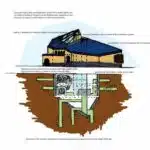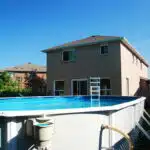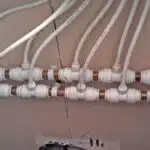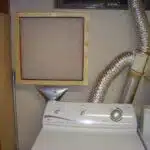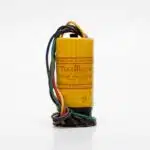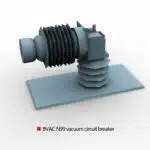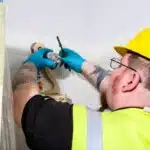Installing a basement sump pump is a crucial task for homeowners in areas prone to heavy rainfall or flooding. A sump pump ensures that excess water is drained away from the foundation of your home, preventing potential damage and costly repairs. However, installing a sump pump can be challenging, especially for those without plumbing experience. In this article, we will guide you through the process of installing a basement sump pump step-by-step and provide essential tips to ensure optimal performance.
Proper installation is critical when it comes to sump pumps as it can affect its efficiency and longevity. It is essential to choose the right size and type of sump pump that matches your needs and basement configuration while adhering to local building codes. Additionally, proper placement of the sump pit and discharge line routing are crucial factors in ensuring that the pump works efficiently in removing water out of your home’s foundation. With this in mind, we will provide you with expert advice on how to install a sump pump correctly, including necessary tools needed and safety precautions to take during installation. By following these guidelines carefully, you can protect your home from potential water damage while enjoying peace of mind during heavy rainfalls or other unforeseen events.
Assessing Your Basement’s Water Situation
Are you tired of dealing with a wet and damp basement? Are you worried about the potential damage that water can cause to your home’s foundation and structure? If so, it may be time to consider installing a basement sump pump. But before jumping into the installation process, it’s important to assess your basement’s water situation.
One option for preventing water damage is waterproofing. This involves adding a layer of protection to the walls and floors of your basement to prevent moisture from seeping in. Some common waterproofing options include sealants, membranes, and drainage systems. It’s important to note, however, that waterproofing alone may not be enough if you live in an area with heavy rainfall or frequent flooding.
Another key factor to consider is the signs of water damage in your basement. Look for any cracks in the walls or floors, peeling paint or wallpaper, musty odors, or mold growth. These can all be indications that there is a problem with excess moisture in your basement. Installing a sump pump can help alleviate these issues by removing any standing water and keeping your basement dry.
By assessing your basement’s water situation and understanding the available waterproofing options, you can make an informed decision about whether or not a sump pump is necessary for your home. In the next section, we’ll discuss how to choose the right type of sump pump for your specific needs and budget.
Choosing The Right Type Of Sump Pump
When it comes to choosing the right type of sump pump, there are several options available in the market. Each type has its own set of features and advantages, making it important to know what you need before making a purchase. Some of the most common types include pedestal sump pumps, submersible sump pumps, battery backup sump pumps, and combination sump pumps.
Pedestal sump pumps are considered to be the most affordable option among all types of sump pumps. However, they are also the least reliable since they have an exposed motor that is prone to overheating and malfunctioning. Submersible sump pumps are more expensive than pedestal ones but offer better reliability as their motors are placed underwater. They also come with a variety of features such as vertical or horizontal switch activation and automatic shut off.
Battery backup sump pumps provide additional protection in case of power outages or mechanical failures. These models rely on battery power to operate when the primary pump fails or when there isn’t any electricity available. Combination sump pumps combine both pedestal and submersible styles into one unit. They offer both affordability and efficiency while maintaining reliability.
- Vertical or horizontal switch activation
- Automatic shut off
- Battery backup for power outages
- Combination units
Now that we’ve compared the cost and features of different types of sump pumps, it’s time to determine the correct size for your basement needs.
Determining The Correct Sump Pump Size
When it comes to installing a basement sump pump, determining the correct size of the pump is crucial. A pump that is too small will not be able to handle excess water flow, while a pump that is too large will waste energy and cost more money than necessary. To calculate the capacity needed for the sump pump, you must first evaluate the drainage in your basement.
To evaluate drainage, start by measuring the square footage of your basement and multiplying it by the height of water accumulation during heavy rain. This will give you an estimated volume of water that needs to be pumped out. Then, take into consideration any additional factors such as the number of plumbing fixtures in your basement or if you live in an area with high rainfall rates. Once you have this information, refer to a sump pump capacity chart to determine the correct size for your specific needs.
A helpful tool to assist with calculating capacity is using a table like the one below:
| Basement Square Footage | Water Accumulation Height (inches) | Estimated Gallons of Water |
|---|---|---|
| 500 | 1 | 208 |
| 1000 | 2 | 834 |
| 1500 | 3 | 1874 |
| 2000 | 4 | 3334 |
| 2500 | 5 | 5208 |
By using this table and following these steps, you can accurately determine the correct size for your sump pump and ensure proper drainage in your home’s basement. In the next section, we will discuss selecting a proper sump pit location.
Selecting A Proper Sump Pit Location
When selecting a proper sump pit location, it is important to choose a dry area away from potential sources of water. Additionally, it is essential to check for water lines or other obstructions that may interfere with the installation. Finally, it is important to confirm the dimensions of the sump pit, as well as the pump, to ensure the proper fit for the installation.
Choose A Dry Area
Choosing the right sump pit location is crucial in ensuring that your basement sump pump functions properly. It is important to choose a dry area for the installation of the sump pit. This means avoiding areas where water tends to accumulate, which can prevent the pump from working efficiently. Additionally, choosing a dry area helps to prevent moisture buildup in your basement, which can lead to mold growth and other related issues.
When selecting a proper sump pit location, it is important to consider the size of the pump you need. Choosing the right pump size ensures that the system will be able to handle any water accumulation effectively. A larger pump may be necessary if you have a larger basement or if you experience frequent flooding. On the other hand, a smaller pump may suffice if you have a smaller space or do not experience heavy rainfall or flooding.
Properly locating your sump pit is vital for ensuring that your basement remains dry and free from water damage. By considering both the size of your pump and choosing a dry area for installation, you can help ensure that your sump pump will function efficiently and effectively for years to come.
Check For Water Lines
In selecting a proper sump pit location, it is crucial to check for existing water lines. This step is important because it helps you avoid damaging any existing plumbing systems during the installation process. You need to know where your water lines are located to determine the best location for your sump pump.
Checking for existing water damage is also essential when selecting a proper sump pit location. Water damage can cause mold growth and other related issues that can be hazardous to your health. Before installing a sump pump, it is important to assess any potential water damage in the area where you plan to install the pit and address the issue before proceeding with installation.
Based on your assessment of the area, you may also need to determine the need for additional drainage solutions. If there is no proper drainage system in place or if the existing system is inadequate, this can lead to flooding in your basement. Installing a sump pump alone may not be enough to prevent this problem from occurring. Therefore, you may need to consider installing additional drainage solutions such as French drains or exterior grading. It is essential to consult with a professional plumbing expert for advice on what additional measures are necessary based on your specific situation.
Confirm Dimensions
When selecting a proper sump pit location, it is essential to confirm the dimensions of the space before installation. Measuring accuracy is crucial in ensuring that the sump pump fits perfectly and functions correctly. The necessary tools for measuring accuracy include a tape measure, level, and square. These tools help you determine the depth and width of your sump pit accurately.
When measuring the dimensions of your sump pit, it is important to consider the size of your basement and the amount of water that could potentially enter through seepage or flooding. A larger sump pit can accommodate more water and reduce the frequency at which your sump pump operates. However, a smaller pit could save space but require more frequent pumping cycles.
Confirming dimensions also helps you select an appropriate sump pump that can handle the amount of water in your basement efficiently. Choosing a pump with insufficient power or capacity can result in frequent breakdowns and costly repairs. Therefore, it is highly recommended that you consult with a professional plumbing expert who can provide guidance on choosing an appropriate sump pump based on your specific needs and budget.
Installing The Sump Pit
The next step in installing a basement sump pump is to install the sump pit. The sump pit is a container that collects water from the surrounding area and funnels it into the sump pump. Waterproofing solutions should be applied to the walls and floor of the pit before installation.
Sump pits can be made of various materials, such as plastic or concrete. It is important to choose a durable material that can withstand heavy use and potential damage. Plastic pits are lightweight and easy to install, but may not be as durable as concrete pits which are stronger and more long-lasting.
When selecting a sump pit, make sure to choose one that is appropriate for the size of your basement and the amount of water it typically collects. The pit should also have enough space around it for easy access during maintenance and repairs. Once you have selected a suitable sump pit, follow manufacturer instructions for installation to ensure proper function.
As we move on to installing the sump pump, it is important to keep in mind that proper installation of both components is crucial for an effective waterproofing system. The sump pit must be installed correctly in order for the sump pump to function properly. Make sure all connections between the two components are secure and leak-free, and that any electrical wiring is installed by a licensed professional.
Installing The Sump Pump
Now that the sump pit has been installed, it is time to move on to the next crucial step in ensuring a dry basement – installing the sump pump. This component is responsible for pumping out any water that accumulates in the pit and directing it away from your home’s foundation. Without a properly functioning sump pump, your waterproofing solutions will be ineffective, leaving your basement vulnerable to flooding and water damage.
Before installing the sump pump, you must first select a backup power option. Power outages are common during storms and heavy rains, precisely when your sump pump is needed most. A battery backup system is an excellent option for ensuring your sump pump continues to work even during power failures. It can provide up to several hours of power when electricity goes out. Having a reliable backup power source ensures that your basement stays dry even without electricity.
Once you have chosen your backup power option, it’s time to install the sump pump itself. First, connect the discharge pipe to the pump outlet and run it outside through a PVC pipe. Then, place the pump into position in the sump pit and secure it by tightening its clamps onto the discharge pipe. Finally, connect the check valve onto the discharge pipe above where it exits through the PVC pipe outside. The check valve prevents water from flowing back into the pit after being pumped out by forcing it towards its designated destination away from your home’s foundation. With these steps complete, you’ll have successfully installed a functional and reliable sump pump system into your basement!
Installing The Check Valve
After the sump pump has been installed, it is necessary to install the check valve to prevent any backflow of water. The check valve is an important component of a basement sump pump as it ensures that water flows in only one direction from the sump pit and not back into it. In order to install the check valve, follow these steps:
- Determine where the check valve will be installed. It should be placed on the discharge line between the sump pump and the outside of your home.
- Cut a section of PVC pipe to fit between the sump pump and the check valve. Make sure that you leave enough space for the check valve to be installed.
- Install the check valve by sliding it onto one end of the PVC pipe and tightening it with hose clamps.
Check valves require maintenance in order to function properly over time. It is recommended that you inspect your check valve every six months or so to ensure that there are no cracks or other issues that could cause problems with your sump pump system. Additionally, if you notice any issues with your system such as strange noises or reduced water flow, troubleshooting may be necessary.
Moving on from installing the check valve, now it’s time to move on to installing the discharge pipe. This step involves connecting PVC pipes from your sump pump and directing them outside your home through a hole in your foundation wall. Properly installing a discharge pipe ensures that any water collected by your sump pump system is directed away from your home’s foundation and prevents flooding in your basement.
Installing The Discharge Pipe
According to recent studies, improper discharge pipe sizing can cause up to 90% of sump pump failures. Therefore, it is crucial to ensure that the discharge pipe is sized correctly. The size of the discharge pipe should be based on the pump’s flow rate and the distance from the sump pump to the outlet.
In addition to proper sizing, it is essential to insulate the discharge pipe properly. Discharge pipe insulation helps prevent condensation from forming on the outside of the pipe, which can lead to mold growth and water damage. It also reduces noise levels and improves energy efficiency by keeping hot water hotter for longer periods.
To install a discharge pipe, start by determining where you want to direct the water. It should be at least 20 feet away from your foundation and not directed towards your neighbor’s property. Once you have determined where you want to direct the water, connect one end of the pipe to the sump pump’s outlet and run it along your basement wall towards its endpoint. Make sure that there are no kinks or bends in the piping as this will reduce its efficiency.
Transitioning into connecting the power supply section, after installing and insulating your discharge pipe correctly, it is time to connect your sump pump’s power supply. Ensure that all electrical connections are made correctly and safely before plugging in your unit. Remember that safety must always come first when working with electricity.
Connecting The Power Supply
When choosing a power supply for a basement sump pump, one should make sure the voltage and amperage ratings are appropriate for the pump. The power supply should also be UL-listed and waterproofed to maintain safety standards. Installing a power supply for a sump pump should be done carefully, making sure to follow the manufacturer’s instructions for proper installation. All wiring should be completed according to local electrical codes. Once installed, the power supply should be tested to make sure it is properly connected and functioning. Testing should include a visual inspection of the wiring and a voltage test to determine the level of power output. Finally, the sump pump should be tested with water to ensure it functions correctly.
Choosing A Power Supply
When choosing a power supply for your basement sump pump, it’s important to consider backup options and perform a cost analysis. While a primary electrical source is the most common choice, it’s also essential to have a backup power source in case of outages or emergencies. One option is to install a battery backup system, which will keep your pump running even if the power goes out. Another option is to use a generator as a backup power supply.
When performing a cost analysis, it’s important to weigh the upfront costs of each power supply option against their long-term costs. While battery backups may have higher initial costs, they require less maintenance and have longer lifespans than generators. On the other hand, generators may be less expensive initially but require regular maintenance and fuel costs that can add up over time.
Ultimately, the decision on which power supply to choose will depend on personal preferences and needs. It’s important to consider all options and perform thorough research before making any decisions. A professional plumber or installation expert can provide valuable insights and help you make an informed decision that fits your budget and needs.
Installing The Power Supply
When it comes to connecting the power supply for your basement sump pump, there are a few important considerations to keep in mind. Running electrical wiring from the power source to the pump requires careful planning and execution to ensure that everything is set up correctly and safely. As a plumbing installation expert, I recommend hiring a professional electrician to handle this aspect of the installation process.
The first step in installing the power supply is to determine where the electrical source will come from and how it will be routed to the pump. This typically involves running wiring from an existing electrical outlet or circuit breaker panel, through walls or floors if necessary, and then connecting it to the pump itself. Depending on your home’s layout and construction, this can be a complex process that requires specialized tools and knowledge.
Once the wiring setup has been established, it’s important to ensure that all connections are properly made and grounded for safety purposes. This may involve installing additional components like fuses or circuit breakers to protect against electrical surges or overloads. Again, I strongly recommend consulting with a licensed electrician who can provide guidance on these matters and ensure that everything is set up correctly. By taking care during this phase of the installation process, you can help ensure that your sump pump has a reliable source of power that will function properly when you need it most.
Testing The Power Supply
Once the power supply has been connected for your basement sump pump, it’s important to test it thoroughly to ensure that everything is functioning as it should. This typically involves checking for voltage at various points along the wiring setup to verify that power is flowing correctly. A licensed electrician can use specialized equipment and techniques to perform these tests safely and accurately.
In addition to testing for voltage, it’s important to double-check that all circuit breakers and fuses are properly installed and functioning correctly. These safety features are essential for protecting against electrical surges or overloads that could damage the pump or even pose a risk of fire. A professional electrician can help you identify any potential issues with your circuit breaker or fuse box and make any necessary repairs or upgrades.
Once all testing has been completed successfully, you can rest assured that your sump pump is ready to perform reliably in the event of a flood or other emergency. By taking care during both the initial installation process and subsequent testing phase, you can help ensure that your home stays safe and dry even during heavy rainfall or other adverse weather conditions.
Testing The Sump Pump
After installing the sump pump, it is important to test the system regularly to ensure that it is functioning correctly. The testing frequency may vary depending on factors such as the location of the house and the amount of rainfall in the area. However, a general rule of thumb is to test your sump pump at least twice per year. A good time to do this would be before the rainy season and after it has ended.
To test your sump pump, pour water into the basin until it reaches the activation level of your pump. This level can be found in the manufacturer’s instructions or by consulting a plumbing professional. Once you have poured enough water into the basin, listen for your sump pump to turn on and begin pumping water out of the basin through your discharge pipe. If everything is working correctly, you should hear water being pumped out and away from your home.
If your sump pump fails to activate during testing, there are several troubleshooting tips you can try before calling a plumber. First, check that power is reaching your sump pump by verifying that it is plugged in and that its circuit breaker has not tripped. If these checks do not solve the issue, inspect all components of your system for damage or wear and tear. It may also be beneficial to consult with a plumbing professional who can diagnose and repair any issues with your system.
To ensure complete protection from basement flooding, consider adding a battery backup system to your sump pump installation. This will provide an extra layer of protection in case of power outages or other emergencies that could cause your primary sump pump to fail. By taking these steps, you can rest easy knowing that your home will be protected from basement flooding throughout any season or weather event.
Adding A Battery Backup System
A battery backup system is an essential addition to any sump pump installation. Power outages can occur unexpectedly, and without a backup power source, your sump pump will fail to work during heavy rainfalls. Installing a battery backup system ensures that your sump pump continues to function even when there is no electricity supply.
The cost of installing a battery backup system varies depending on the type of unit you purchase and the complexity of the installation process. On average, homeowners spend between $300 and $500 for a basic backup system that includes a battery, charger, control panel, and alarm. However, high-end systems with additional features such as remote monitoring can cost upwards of $1000.
It is important to understand the maintenance requirements of your battery backup system. Regular testing and inspection are necessary to ensure that the batteries are functioning correctly and have enough charge to last through an outage. Replacing batteries every three years is recommended to avoid potential failure during an emergency situation.
Next up, we will discuss the maintenance and upkeep of your sump pump, which is critical in ensuring it remains operational when you need it most.
Maintenance And Upkeep Of Your Sump Pump
Regular maintenance of your sump pump is crucial to ensure its functionality and longevity. Neglecting it could lead to costly repairs or replacements down the line. As a responsible homeowner, you must take proactive steps to maintain your sump pump regularly.
One of the most common problems that homeowners face with their sump pumps is clogging. Dirt, debris, and other foreign objects can accumulate in the pump’s basin and impede its ability to function correctly. Regular cleaning of the basin and checking for any blockages in the discharge pipe can prevent this problem.
Another issue that homeowners may encounter is a faulty switch or float. If your sump pump fails to turn on or off automatically, it could be due to a malfunctioning switch or float. In such cases, it’s best to consult a professional plumber who has experience in handling sump pumps.
To ensure that your sump pump operates efficiently, you must perform regular maintenance checks and address any issues promptly. By doing so, you’ll not only extend the lifespan of your equipment but also have peace of mind knowing that it will be there when you need it most. In the next section, we’ll discuss some common issues that homeowners face with their sump pumps and how they can troubleshoot them effectively.
Troubleshooting Common Issues
- In order to properly install a basement sump pump, it is essential to first check the power supply.
- The pump should be tested to ensure it is functioning properly before installation.
- The drainage system should also be inspected to ensure all components are in good condition.
- Any obstructions or blockages in the drainage pipes should be cleared before installation.
- It is also important to verify that the pump is properly connected to the power source.
- After all checks have been carried out, the pump can be installed and tested for correct operation.
Checking The Power Supply
The first step in troubleshooting common issues with a basement sump pump is to check the electrical power supply. This involves ensuring that the pump is properly connected to an electrical outlet and that the circuit breaker or fuse for the pump is functioning correctly. Checking electrical connections and fuses should be done with caution, as there is a risk of electric shock. It is important to ensure safety when dealing with electricity by wearing appropriate protective gear and turning off the power before working on any electrical components.
When checking the power supply, it is also essential to verify that there are no tripped breakers or blown fuses. These can cause power failures and prevent the sump pump from functioning properly. If this occurs, resetting the breaker or replacing the fuse may solve the problem. However, if this does not work, it may be necessary to call a professional plumber or electrician to diagnose and repair any underlying issues.
In conclusion, checking the power supply is crucial in troubleshooting common issues with basement sump pumps. Ensuring safety when dealing with electricity must always be a top priority, so proper precautions should be taken before working on any electrical components. By verifying that all connections are secure and checking for tripped breakers or blown fuses, homeowners can easily identify and resolve many sump pump problems without needing to call in outside help.
Testing The Pump
After checking the power supply, the next step in troubleshooting common issues with basement sump pumps is to test the pump itself. This involves checking for any visible signs of damage or wear, such as cracks or corrosion on the pump housing or impeller. It is also important to ensure that the pump is properly secured and grounded.
To test the pump’s functionality, homeowners can pour water into the sump pit until it reaches a level that should trigger the pump to turn on. If the pump does not activate, it may be necessary to check for clogs or obstructions in the discharge pipe or impeller, as these can prevent proper operation. Additionally, testing backup options such as battery-powered pumps can help ensure that homeowners are prepared for power outages or other emergencies.
Regular maintenance tips can also help prevent common sump pump issues and extend its lifespan. This includes cleaning debris from the sump pit regularly and ensuring that all components are properly lubricated and free from damage or wear. By taking these steps, homeowners can avoid many potential issues with their basement sump pumps and ensure reliable performance when it is needed most.
Checking The Drainage System
Checking the drainage system is an important step in troubleshooting common issues with basement sump pumps. It is crucial to ensure that water is flowing away from the foundation and not pooling around the sump pit. When checking drainage, plumbing installation experts look for signs of improper grading or landscaping, as these can cause water to collect and flood the basement. Homeowners can troubleshoot this issue by inspecting the area around their home’s perimeter and making any necessary adjustments to ensure proper grading.
It is also important to check for clogs or obstructions in the discharge pipe, which can prevent water from flowing freely away from the home. Plumbing installation experts recommend using a plumbing snake or similar tool to clear any debris from the pipe. Homeowners can also take a DIY approach by using a garden hose to flush out any blockages. Additionally, ensuring that gutters and downspouts are clear and properly directing water away from the foundation can help prevent drainage issues.
In conclusion, checking the drainage system is an essential part of troubleshooting common issues with basement sump pumps. By looking for signs of improper grading and inspecting for clogs or obstructions in the discharge pipe, homeowners can prevent potential flooding and extend their sump pump’s lifespan. Incorporating regular maintenance tips into their routine will help avoid costly repairs and ensure reliable performance when it matters most.
Safety Precautions During Installation
Before installing a basement sump pump, it is essential to take the necessary safety precautions. Failure to do so can result in serious injuries or even death. One of the most critical aspects of the installation process is ensuring proper ventilation. The basement area where you install the pump must have adequate air circulation to prevent dangerous fumes from accumulating.
Proper attire for installation is another essential aspect of safety during sump pump installation. It is crucial to wear protective clothing such as gloves, goggles, and long-sleeved shirts to prevent injuries from sharp objects or hot surfaces. Additionally, wearing rubber-soled shoes will reduce the risk of electric shock if there are any electrical wires nearby.
In summary, taking safety precautions during sump pump installation cannot be overemphasized. Proper ventilation should be ensured, and protective clothing must be worn at all times during the process. Neglecting these fundamental aspects can lead to severe consequences such as injuries or death. In the subsequent section, we will discuss why hiring a professional sump pump installer may be a better option for those who lack experience in handling plumbing installations safely.
Hiring A Professional Sump Pump Installer
According to research conducted by HomeAdvisor, the cost of hiring a professional sump pump installer ranges from $650 to $2,500. This amount is influenced by several factors such as the type of pump selected, the extent of excavation required, and the complexity of plumbing installation. While some homeowners may opt for a DIY approach to save on costs, it is important to note that quality workmanship cannot be guaranteed unless one has prior experience in plumbing installations.
When it comes to installing a basement sump pump, there are several compelling reasons why hiring a professional may be the best option. First, professionals have access to high-quality equipment and tools needed for plumbing installations. They also have extensive knowledge and skills in handling complex installations, ensuring that every aspect of the job is done correctly.
Secondly, working with a professional guarantees quality workmanship. This means that you can rest assured that your sump pump will function efficiently for years without any issues. It also saves you money in the long run since you won’t have to deal with costly repairs or replacements due to shoddy installation work.
To sum up, when choosing between DIY vs. hiring a professional sump pump installer, it’s essential to weigh cost vs. quality carefully. While DIY may seem like an affordable option at first glance, it’s vital to consider the potential risks involved in going down this route. On the other hand, hiring a professional ensures quality workmanship and peace of mind knowing that you’re getting value for your investment. Ultimately, making an informed decision based on your specific needs and constraints will help guarantee a successful outcome for your basement sump pump installation project.
Conclusion
In conclusion, installing a basement sump pump may seem daunting at first, but with the right tools and knowledge, it can be done successfully. Remember to assess your basement’s water situation and choose the appropriate type and size of sump pump. It is crucial to select a proper location for your sump pit and install it correctly. Also, regular maintenance and upkeep of your sump pump are essential for its longevity.
As the saying goes, “an ounce of prevention is worth a pound of cure.” Investing in a basement sump pump installation can save homeowners thousands of dollars in water damage repairs in the long run. However, safety precautions must always be taken during installation to avoid any accidents or injuries.
If you are unsure about installing a sump pump yourself, it is best to hire a professional plumber with experience in this area. With their expertise, they can ensure that the job is done correctly and efficiently, giving you peace of mind knowing that your home is protected from potential water damage.
Image Credits





